Text
Beale St. Handy Home Owner MIA?
WC Handy wrote the lyric ‘If Beale Street could talk,’…and lordy we wish the street could talk enough to tell us who owns the Handy Home Museum at 352 Beale Street. We also need to verify that the Father of the Blues owned and lived in the Handy Home. Once we verify the historical provenance of the home then the owner could start performing the many-needed repairs and upkeep. Unfortunately, we have been told by the City that two different owners have rights to the home, the City of Memphis and Mr. John Elkington of the now defunct Performa Entertainment Real Estate, Inc. Neither the City nor Mr. Elkington will provide the name of the previous owner who sold or donated the home nor will they repair the roof, the fence and the water pipe that has been broken for nearly 10 years as reported by other business owners on Beale St. who routinely open their restrooms up for museum visitors and staff.
We identified one more potential owner who may have a claim to the home due to a potential defect in title to the home, the grandchildren of Handy’s neighbors, WH Holloway and his wife Rebecca who lived at 659 Jennette Place in the home now located at 352 Beale St. Lot 659 is the lot adjacent to WC Handy’s lot at 657 Jennette Place.
In 2016, we visited the Handy Museum on Beale St and noticed the home was hidden behind an overgrown tree, we also noticed missing shingles from the roof scattered in the yard, boards popping off the side of the house, missing light bulbs and light covers, and we learned there was no running water in the museum. Dr. Carlos Handy, the only living grandson of WC Handy was shocked, disappointed, and angered to see the condition of the home. The dilapidated home casts a poor reflection on the legacy of WC Handy Father of the Blues, and the Handy family. We met with Mayor Strickland in February 2017 to discuss the future of the Handy Home and we were told the home belonged to the City of Memphis and was supposed to be transferred to the City years ago by the presumed owner and holder of the papers, Mr. Elkington. The City claimed that as soon as the paperwork for the home was delivered by Mr. Elkington, the City would start repairs. The City offered to inspect the home for Dr. Handy and agreed to send an Inspection Report to the Handys. The inspection was completed and the report was delivered by Spring 2017. We also requested an inventory and proof of insurance for the home, and neither have been delivered. Over the last 30-plus years, the Handy Foundation has loaned Handy artifacts, family letters and photographs, and other Handy historical items to the museum.
During that visit to Memphis we attempted to locate 659 Janette Street and learned from the City and Shelby County records that Memphis has never had a street named Janette. However, there is a Jennette Place. Realizing the name of street was incorrect we logically concluded that possibly the house number was incorrect. We ordered a title search for 659 Jennette Place and learned Handy never owned that home. A search of all properties on the block revealed that Mr. Handy purchased the home next door at 657 in January 1911. Nearly 100 years later, the Handy’s home at 657 was destroyed by a fire and unceremoniously demolished in 2011 per the City records. Let that fact set in for a moment, and you too will feel the deep blue-depression we are feeling at the Handy Foundation. The neighbors still remember the fire.
Today, there is no historic marker at 659 or 657 Jennette Place. We have plans to apply for a historic marker to honor the place where Handy’s house stood at 657 Jenette Place in the neighborhood behind Stax Museum. WC Handy and his wife Elizabeth raised their family in a shotgun home at 657 Jennette Place, and the couple entertained their friends and neighbors and WC Handy composed great American standards including Beale Street Blues, Memphis Blues, and St. Louis Blues among countless other hits.
Why the editors of Handy’s autobiography used an erroneous address in WC’s autobiography Father of the Blues is a mystery to us. The autobiography tracks the Handy’s move from a rental home on Ayers Street in Memphis to a home they purchased in Memphis. Handy dictated the book into a Dictaphone. We have a Handy Dictaphone on display at the Blues Hall of Fame in Memphis along with a Handy typewriter. Father of the Blues was inducted into the Literary Hall of Fame at the Blues Foundation in May 2017. The book display will be open to the public until May 2018.
Then we heard about the 1990 lawsuit filed in Chancery Court of Shelby County, The Blues Foundation v Joe Savarin & John Elkington et all, and read the Court Order signed by the Judge stating John Elkington owns the Handy Home. A search of public records of Elkington’s business and personal inventories during his bankruptcy and divorce proceedings does not list the Handy House as an asset. A public records search of the City’s assets, the assets of Beale Street Development Corporation, Beale Street Management’s assets, and the Blues Foundation assets does not reveal a claim of ownership by any entity listed. The IRS was unable to locate an owner by a name-based reverse search of historical assets.
However, we did find the Handy Home listed as the keystone asset of the public records of the multi-million-dollar federal grants applications submitted to the Federal Government for Beale St to receive the Historical Designation and all benefits including millions in grants and millions in tax breaks. In the grant applications, the relocated Handy Home is positioned on Beale St to be the ‘Gateway to Beale Street.’ Perhaps in the haste to get the grant applications written and submitted for federal funding and tax breaks, a title search was never pulled and the wrong home was inadvertently moved to Beale St. Or perhaps the error was discovered when the researchers realized Janette St did not exist, and the decision was made to move the home anyway. I am disturbed by the current sign in front of the home on Beale St boldly displaying the statement ‘The house was moved here from 659 Janette St…’, a street that never existed in Memphis. Whoever printed the sign or directed the printing of the sign must have known of the error, and decided to print the inaccurate address with little regard for the actual name of the street or the home’s provenance.
WC Handy’s company, Handy Brothers Music Company, Inc. will turn 100 years old in 2018 and the Board of the Handy Foundation is planning Centennial Celebrations for the oldest American entertainment company still family owned and operated. Events will commence in multiple cities in multiple states. Before the Centennial Celebrations begin, we ask that the owner of the Handy Home come forward, claim ownership and disclose who sold or transferred the home to them.
If the home was never owned by WC Handy, then the owner must stop using the Handy name to promote the Holloway’s home AND return all gifted or loaned Handy artifacts to the Handy Foundation. If the true owner proves the Handy Home’s historical significance and provenance then we ask that the needed repairs, maintenance and upkeep commence at once so Blues lovers everywhere may visit the Handy Home in 2018 to celebrate the life and music of WC Handy Father of the Blues and America’s oldest family owned and operated entertainment company Handy Brothers Music Company, Inc.
Mary Jane Hancock, Esq does not speak for the Board of the WC Handy Foundation and all views expressed herein do not necessarily represent the views of other Board. [email protected] www.WCHandyFoundation.org Submitted August 6, 2017
END
0 notes
Text
BB King Museum
by Jane Brown

OutboundMusic’s Blues Road Trip of 2015 comes to Indianola, MS, in search of a Lady Lucille and the museum dedicated to celebrating the music and memory of the King of the Blues, Riley B. King himself—“BB” to you, me and to the millions of fans worldwide who’d recognize anywhere the sound of Lucille’s voice singing under BB’s caress. The B.B.King Museum and Delta Interpretive Center, located at 400 Second Street in King’s Mississippi hometown, is so much more than a tribute to this Blues icon. It is a repository of memorabilia honoring the supreme practitioner of that uniquely American art form, the Blues, as well as a compendium of educational exhibits and programs designed to preserve the rich culture and music heritage of the Mississippi Delta.
Where to start? The Museum offers art, artifacts, video and other educational programs. Its theater introduces the visitor to the King of the Blues, after which exhibits are divided into “Galleries” which illustrate various periods in B.B.King’s career, as well as the life and tenor of the times. From his life as a Delta sharecropper in the 1930s to his sojourns in Memphis during the 40’s and 50’s, where the WDIA DJ nicknamed “Beale Street Blues Boy” and later “Blues Boy” became B.B. King, the Galleries proceed to 1960s work on the southern Chitlins’ circuit, the influence of the Civil Rights movement, and international fame. Visitor’s move on to an interactive experience where they can play real instruments and make Blues music themselves. You can bet OutboundMusic is having fun here!
Riley B “B.B.” King, 89, passed away on May 14, 2015. On May 27, 2015, King’s body was flown to Memphis. The funeral procession led down Beale Street, with a brass band marching in front of the hearse, playing “When the Saints Go Marching In”, as mourners called out “BB.” After a visitation and viewing on May 29 at the B,B,King Museum and Delta Interpretive Center, he was buried at the museum on May 30. His albums came in a steady succession. So did the Grammy awards. In 1987 he received the Lifetime Achievement Award from The Recording Academy. He was a Kennedy Center Honoree in 1995. He was awarded the Presidential Medal of Freedom by President George W. Bush in 2006, and the prestigious Polar Music Prize which has been called “The Nobel Prize of Music” in Sweden. His guitar is on the current Mississippi license plate.
Take it home, BB!
0 notes
Text
Delta Blues Museum
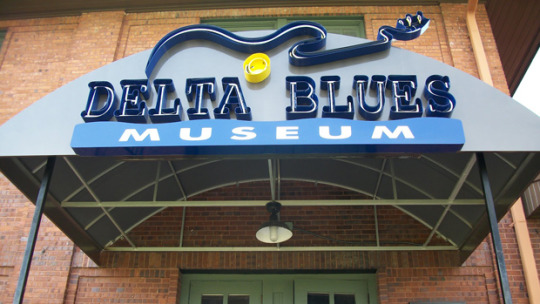
by Jane Brown
When Bing Crosby sang the Cavanaugh/Barris hit It’s a Treat to Beat Your Feet on the Mississippi Mud in 1928, he wasn’t just whistling Dixie. OutboundMusic’s Blues Road Trip of 2015 takes us to the Delta Blues Museum on the Mississippi Blues Trail, No. 1 Blues Alley in Clarkesdale, Mississippi. Continuing the soiliness, this little gem of a museum, a 2013 finalist for the National Medal for Museum and Library Service, is in large part funded with money raised from the proceeds of sales of “Muddywood” guitars constructed from fallen boards ZZ Top guitarist Billy Gibbons found at the house where Muddy Waters once lived on the nearby Stovall plantation. A Muddy Waters wing was added to the museum in 2012 where sit the remains of the plantation shack. Other blues artists, as well as other noted literary, visual, and folk artists, have exhibited their works here.
The Delta Blues Museum claims the title of the world’s first Blues museum, founded in 1979 by Sid Graves, director of Clarksdale’s Carnegie Public Library. DBM now houses several exhibits honoring the history of the Blues, and its Delta Blues Education Program provides training for many young future Blues greats, who perform at local festivals and concerts and on tour. Book signings and panel discussions are part of the Museum experience here. Various memorabilia such as guitars and performance clothing, as well as a short film, round out the museum experience. We’re just sittin’ at the Crossroads of Hwys 69 and 49, channeling Muddy and his pals.
0 notes
Text
Crossroads
by Courtney Delaney
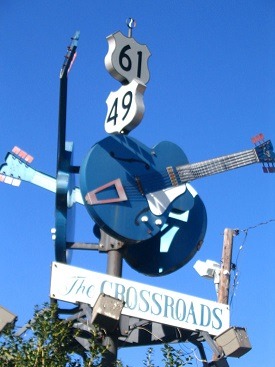
Nobody really knows for sure whether it was delta blues musician Tommy Johnson (1896 – November 1, 1956) or delta blues musician Robert Johnson (May 8, 1911 – August 16, 1938), or both, who traded his soul to the devil in exchange for musical talent. Nobody knows for sure where this legendary transfer occurred. Nobody even knows if it ever really happened.
Legend has it, Robert Johnson traded his soul to the devil at the crossroads he wrote about in his song “Crossroads”. The song doesn’t mention anything about a pact with the devil. The lyrics seem to be about failed attempts to hitch a ride at the crossroads. But legend has it, Robert Johnson made his deal with the devil there, and legend has it that this crossroads is in Clarksdale, MS at the intersection of old US 61 and old US 49.
Or…legend has it that the crossroads is in Rosedale, MS.
Or…legend has it Robert Johnson made his pact at a crossroads near Dockery Plantation in Dockery, MS.
Or…legend has it that it was Tommy Johnson, and it may have been a graveyard or a crossroads…or a crossroads in a graveyard.
Legend has it, OutboundMusic toured the blues trail in October of 2015.
0 notes
Text
Beale Street
by Jane Brown
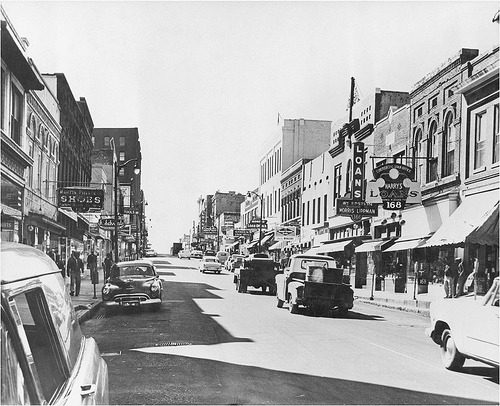
OutboundMusic’s Blues Road Trip of 2015 struts its stuff on the cobblestones of old Beale Street, moving to the music of the innumerable legends whose creativity flowered on this Memphis, Tennessee, thoroughfare. Created in 1841, “Beal Avenue,” as it was originally named, began to attract many traveling African-American musicians in the 1860s and remains a mecca for musicians of every genre even today. Entertainer Danny Thomas, who established St. Jude’s Children’s Hospital in Memphis during the 1950s, penned his hit song, “Bring Back My Beale Street,” and “Beale Street” as we know it was born. Incidentally, St. Jude reaped the profits from the success of that song. Sometimes called the Soul of Memphis, in 1977 an act of Congress officially declared Beale Street the “Home of the Blues.”
The Blues! By the 20th Century Beale Street was home to a heady of mix night clubs and honky-tonks, as well as churches and businesses. Music from new immigrants and music from old negro spirituals and ancient African rhythms and music from homemade jug bands melded together and in 1909, W.C.Handy wrote what is considered to be the first blues song, “Boss Crump Blues,” later dubbed “The Memphis Blues.” St Louis Blues followed in 1913, and a new American musical genre was born. W.C. Handy’s Memphis home and museum at Beale and Fourth Streets are open to the public.
Despite the down times of the Great Depression and the wrecking balls of 1960s and ‘70s urban renewal, Beale Street has survived and flourished as the entertainment district of Memphis. The Beale Street Brass Note Walk of fame honors over 80 famous and lesser known musicians and others in the industry who have made Memphis the music mecca it is. Among those who have been honored: Alberta Hunter, Elvis Presley, Ma Rainey, B. B. King, Justin Timberlake, Ruby Wilson, Jerry Lee Lewis, Furry Lewis, Memphis Minnie, and of course W. C. Handy.
0 notes
Text
WC Handy Museum
by Courtney Delaney

OutboundMusic’s Blues Road Trip of 2015 brings us to the WC Handy Museum today. This is fittingly our first official stop of the tour. The WC Handy Museum in Florence, Alabama is the actual birthplace and childhood home of the Father of the Blues, William Christopher Handy.

WC Handy’s historical significance in music and music business is expansive. He is famous for composing the songs “Saint Louis Blues”, “Memphis Blues”, “Beale Street Blues” and many other favorites. He was hired by EH Crump to write a song to help draw attention to his campaign as he sought election as mayor of Memphis. The song was titled “Mister Crump” or “EH Crump Blues” (varying reports) and blended the blues and ragtime styles of music. Crump was elected mayor of Memphis in 1910.
WC Handy is credited with introducing the 12-bar blues style of music that came to identify American Blues. He was a pioneer of the music publishing industry, owned a record company, collaborated directing the motion picture “Saint Louis Blues” in 1929 and wrote 5 music-related books. This short paragraph only scratches the surface of his contribution to music history.
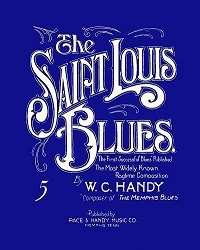
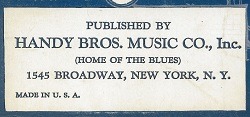
The museum itself displays his trumpet, hand-written music, the piano he used when composing and much more.
0 notes
Text
New Single, West Coast Ghost, Released by The Chance
by Al Delaney

“West Coast Ghost” is the first release off a new project by the Baltimore band The Chance. This is a good listen. The Chance uses a nice blend of Pop and Punk to lay out an interesting story line that touches on a long-distance romance. The song itself is well crafted. The performance is outstanding and the production dynamic. As good as this song is, there’s a more compelling reason to follow these guys and their music. They’re fresh, talented and proven—their first project “No Big Deal” also had keepers.
The Chance performs in small clubs around the Baltimore area. That’s something to take advantage of. A great opportunity to see talented band before they grow beyond their roots. If they keep putting out music like this they won’t be playing small clubs for much longer.
We’ve just placed this song in high rotation on OutboundMusic – Mix Radio. Tune in to listen!
0 notes
Text
Music for Film: Make It Easy to Clear Rights
by Courtney Delaney
If you are a songwriter or artist who pitches songs directly to opportunities for film and television, it’s important to get all your ducks in a row with regard to legal rights before pitching. Consider this scenario: A film production company has narrowed it down to two songs for use in their film, your song and one other song. The film production company likes both songs equally.
In order to include either song in the film, the production company must attain either
1) a synchronization license (for use of the song itself) and a master use license (for use of the recording)
or
2) an all-in license that combines both the synchronization and master use licenses when both rights are owned by one person or company.
For simplicity’s sake, let’s say you wrote your song, hired musicians for the studio recording, and paid a producer to create the sound recording. You registered a form PA with the Library of Congress for the song; you registered form SR with the Library of Congress for the recording, listing all participants. You might expect you own all the rights. However, for use of the song in film, the production company will need permission from the producer and all performers unless other legal agreements are in place. Other than your copyright registrations, you have no other legal documentation.
In this scenario, let’s say the songwriter for the other song has on file his PA and SR copyright registrations along with work-for-hire agreements* between himself and the producer and each performer. These agreements state that in exchange for what they were paid, the participant waives the right to license the recording and they are not entitled to additional compensation.
Guess which song will be selected? Yes, the other songwriter’s song will most likely be used. That song will be easy to clear for licensing.
I can offer some practical suggestions for lining up your ducks.
Get your hands on a standard work-for-hire agreement template. You can find such a template online or you can hire an attorney to draft the document.
Register form PA with the Library of Congress. Be thorough. If you wrote the lyrics and paid a composer to write the music, by all means, have a work-for-hire agreement in place with that composer. You can note a contribution as work-for-hire on the form PA, but you still need the contract in your possession.
Before recording, have each participant you’ve hired sign a completed work-for-hire agreement. Once you have the studio recording, register the form SR with the Library of Congress, listing each participant and indicating that his/her contribution is “work for hire”.
If you want a participant to be compensated by a portion of ownership to rights, have legal agreements documenting those terms. I recommend you set terms that allow you to collect all payments and royalties and then disperse as agreed. This will keep it streamlined for issuing an all-in license.
To go the extra mile, you might put together a pdf showing copies of both copyright registration forms along with each work-for-hire agreement or alternate agreement for each song. When submitting your song for consideration in a film, you can mention that you have pre-cleared the license and have all documentation available should they need to see it.
*in some states, work-for-hire agreements are not allowed for union musicians
0 notes
Photo

Kelvin Evans is a man who knows no limits when it comes to playing the saxophone. While subtly influenced by artists such as Gerald Albright, Kirk Whalum, Najee, John Coltrane, and Grover Washington Jr., his style is unique. He plays with great passion and skill.
Four of Kelvin Evans songs are currently in rotation on the free online jazz radio station, OutboundMusic - Gravity Radio.
0 notes
Text
Partnering with Artists
The artists we broadcast share 85% of the radio-generated ad revenue. Additionally, our artist-partners receive 85% of the retail price from sales of music and merchandise through their Outbound Music store. For more information about music submissions or to partner with us go to outboundmusic.com/about/submit
0 notes